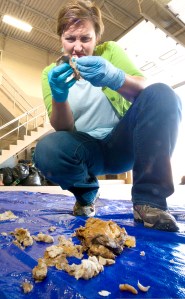AUBURN — Aubrey Strause reached her blue-gloved hands into the fragrant wad of goo, carefully picking it apart, layer by layer.
“A lot of this is just paper towels,” said Strause, an engineer at Verdant Water, a Maine firm that focuses on stormwater and sewer infrastructure issues. “This, I don’t know what these are. If I had to guess, I’d say it’s a face wipe — the kind of thing ladies wipe their makeup off with at night.”
The wad was pulled from a sewer line near Royal Oaks on Wednesday morning by Auburn Sewer Department crews, a big part of a much larger clog crews had to clear.
“The thing about these products, they don’t tell you they shouldn’t be flushed,” she said. “But they shouldn’t.”
It’s becoming a problem in that area of Auburn, sewer Superintendent John Storer said, and the district is looking for answers.
“We just really want to know where these are coming from, so we can talk to the person doing it,” Storer said. “Could they be residential products, commercial cleaning products or could they be passed out at restaurants for cleaning hands and other things? We just want to them to stop.”
That’s why he called in Strause on Friday afternoon. She’s one of Maine’s biggest advocates for safe flushing.
Strause is president of the Maine Water Environment Association and a nationally recognized expert on the science of sewer clogs. She volunteered to take a look.
“I can tell generally the type of product,” she said. “Is it a baby wipe? Or is it a flushable wipe or a shop wipe a mechanic might use? I can even tell down to the brand, based on some of the patterns.”
Strause carries a notebook full of wipe pattern samples, sort of a field guide to sewer clogs. She can identify most kinds of wipes by the way they are folded, by the weave of their fabric and designs printed on them.
“The baby wipes are usually the easiest to sort out,” she said. “They have the cutesy pattern on them. No baby wipes in the United States are flushable.”
She examines similar clogs regularly around the country, sorting paper towels from tampons from premoistened wipes and towelettes. It’s the only way to find out just what is causing the clogs and hopefully identifying the flusher.
The premoistened wipes are the real problem. They can include baby and diaper wipes — thicker and sturdier than most — more delicate adult wipes and household cleaner wipes.
The adult wipes are becoming more popular and they are marketed as being flushable, but they may not break apart in the water the way toilet paper does.
“There are a (ton) of products that are labeled ‘flushable’ but really they should not be,” she said. “Manufacturers won’t label these things as not being flushable because they say they’re going to lose business.”
Storer said the district is in a constant state of battle to keep the lines clear, going so far as to purchase a dedicated $332,000 vacuum truck to suck up potential blockages.
“People think they are bypassing the landfills if they flush it, but they are not,” Storer said. “Flushing the toilet is not magic. If it’s not getting bound up in pumps or in our pipes and causing backup problems, they go to our treatment plant and get screened out. And eventually, they wind up in the landfill.”
The drains near the Auburn Mall apartments have been a regular problem. It’s a point where multiple sewer lines meet, coming from residential areas, restaurants and retail areas.
Crews discovered the massive clog Wednesday morning. The vacuum truck pulled most of the clog out. It’s drained and collected and eventually shipped off to a landfill. They filled a five-gallon bucket with a sample that could be studied and classified.
The clog Strause inspected Friday didn’t turn up any answers. The foul-smelling wad contained a few Wal-Mart branded baby wipes, some Clorox bleach wipes used to disinfect counters and tables, and some makeup-removing wipes. She declared the makeup wipes, with little exfoliating bumps, to be the strongest wipes she’d ever tested.
None of them, and none of the grease-soaked paper towels that made up the bulk of the clog, should have been flushed down the toilet.
“We are finding a ton of different products, all of which should not be flushed,” she said. “In each of these handfuls there might be like one wipe stuck in the center, with the paper towels all around it. Every single one of these clumps might have a baby wipe at the center.”
Storer was disappointed.
“It’s kind of discouraging that it could be coming from 10, 15 different places,” Storer said. “We’d like to give our guys some idea of the source. But today, after this, it doesn’t look like there’s going to be an easy fix.”
CLICK HERE TO WATCH A VIDEO OF THE DISSECTION



Comments are no longer available on this story